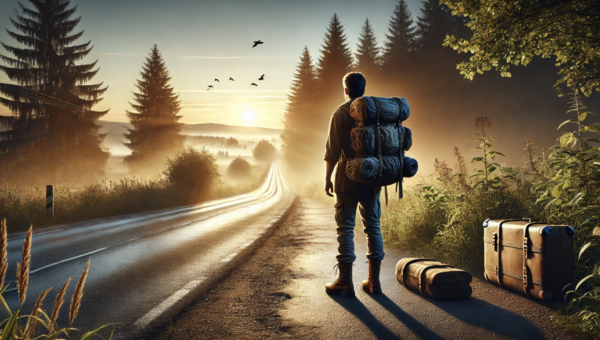Imagine if Harry Potter had never received his Hogwarts letter. If Katniss Everdeen had let her sister take her chances in the Hunger Games. If Peter Parker had never been bitten by that radioactive spider. No wands, no rebellion, no web-slinging—just ordinary people living ordinary lives. Sounds dull, right? That’s because these moments aren’t just exciting plot points; they’re the spark that ignites the entire story.
These are inciting incidents—the game-changing moments that flip a character’s world upside down and force them to take action. Without them, there’s no adventure, no conflict, no reason for the story to exist. But what exactly is it? It can also be known as ‘story spark’, ‘catalyst event’, ‘narrative spark’, ‘initial conflict’, ‘moment of change’, ‘turning point’, and many other terms. But why does it matter so much?
In this article, we’ll break down the inciting incident definition, explore why it’s the backbone of any compelling story, and show you how to craft one that hooks readers from the start. Whether you’re writing your first novel or just want to understand why certain stories grip us so tightly, you’ll walk away knowing exactly how to wield this storytelling superpower. Because let’s face it—without that first push, even the greatest characters would never take the leap.
What Is an Inciting Incident? (And Why Should You Care?)
A turning pointis a moment in a story when everything changes. It’s the unexpected event that yanks the protagonist out of their ordinary life and forces them onto a new path—whether they like it or not. Without it, there’s no story, just a character aimlessly wandering through life.
Think of it as the catalyst that kicks off the plot. It’s the moment Cinderella gets invited to the ball, Frodo inherits the One Ring, or Neo learns the Matrix is real. If these things didn’t happen, they’d all stay stuck in their mundane worlds, and we’d be stuck watching them do absolutely nothing.
To put it in real-life terms, imagine if Luke Skywalker had just stayed on his farm, milking space cows and whining about power converters. No Death Star, no lightsaber duels—just a farm boy with chores. Thrilling, right? (Spoiler: It’s not.)
An effective story spark creates urgency, raises stakes, and forces a choice. The character can’t just ignore it—they must react, setting the rest of the story in motion.
So, why should you care? Because if you’re a writer, your story’s success hinges on this moment. Nail it, and you’ll hook readers instantly. Mess it up, and they might check out before the adventure even begins. Let’s make sure that doesn’t happen.
The Inciting Incident Formula: The 3 Must-Have Ingredients
A great story spark isn’t just any random event—it follows a clear formula. Think of it like spilling coffee on your shirt five minutes before a big meeting. That single moment forces you to react, leading to a chain of events that could change your entire day (or, in storytelling terms, your character’s entire life).
Here’s the three-part recipe that works every time:
1. Disruption – Shake Up the Status Quo
Something happens that completely alters the protagonist’s normal world. It could be thrilling (winning the lottery), tragic (losing a loved one), or just plain weird (getting a mysterious letter from a magical school). But one thing’s for sure: life will never be the same.
Example: Katniss Everdeen’s peaceful life shatters when her sister’s name is drawn for the Hunger Games.
2. Decision – Force the Protagonist to React
The catalyst event doesn’t allow the protagonist to sit back and ignore it. They must make a choice—whether willingly or by force—that pulls them into the story’s conflict.
Example: Katniss doesn’t just watch; she volunteers as tribute, setting the entire story in motion.
3. Direction – The Point of No Return
After this moment, there’s no going back. The protagonist is on a new path, and the story’s true journey begins.
Example: Once Katniss steps into the arena, her life is forever changed—there’s no returning to District 12 as the same girl she was before.
A weak narrative spark leaves the protagonist with an easy escape. A strong one demands action and seals their fate. Spill-proof your story by making sure it follows this formula!
What Is the Inciting Incident of a Story? (With Famous Examples)
If you’ve ever been completely hooked by a book, movie, or TV show, chances are the catalyst event is to blame. This is the moment that forces the protagonist to act, kicking off the entire plot. Without it, there’s no story—just a character sitting around, waiting for something interesting to happen.
Let’s break down some of the most iconic ones in storytelling and see why they work so well.
- Harry Potter and the Sorcerer’s Stone – The Hogwarts Letter Arrives
Harry Potter’s life with the Dursleys is miserable but uneventful—until letters from Hogwarts start flooding in (despite Uncle Vernon’s best efforts to burn, hide, and flee from them). When Hagrid bursts through the door and delivers the truth—”Yer a wizard, Harry”—Harry is forced to step into a world he never knew existed. Without that letter? No magic, no Hogwarts, no Voldemort showdown—just a kid stuck under the stairs.
- Breaking Bad – Walter White Gets Diagnosed with Cancer
Walter White starts off as an overqualified, underpaid chemistry teacher. But when he’s diagnosed with terminal cancer, he’s faced with a brutal truth: his family will struggle financially after he’s gone. His desperation pushes him to start cooking meth, transforming him from a mild-mannered teacher to a criminal mastermind. Without that diagnosis? No Heisenberg, no blue meth empire—just another boring chemistry lesson.
- The Lion King – Mufasa’s Death
Simba is living the carefree cub life—until Scar engineers Mufasa’s tragic death and convinces Simba that he’s responsible. Overcome with guilt, Simba flees the Pride Lands, setting him on a path of self-discovery (and some “Hakuna Matata” therapy). But until Mufasa dies, there’s no reason for Simba to leave. The entire story hinges on that moment.
What Do These Have in Common?
- The protagonist’s world is shattered.
- They are forced to make a choice.
- There is no turning back.
A great call to adventure demands action and launches the protagonist into a journey they can’t ignore. The bigger the stakes, the more gripping the story. So when crafting yours, ask: Is my protagonist truly being pushed into the unknown? If not, it’s time to raise the stakes.
Where (and When) Should the Inciting Incident Happen?
Timing is everything when it comes to a catalyst event. Drop it in too early, and your audience won’t have any connection to the protagonist yet. Wait too long, and they’ll lose patience before the story even starts.
The sweet spot? Within the first 10-15% of the story.
This gives readers just enough time to understand the protagonist’s “normal world” before everything gets turned upside down. We need to see Cinderella scrubbing floors before she gets that invitation to the ball. We need to watch Frodo living his peaceful hobbit life before Gandalf hands him the One Ring. Without that setup, the disruption won’t feel nearly as powerful.
But beware of waiting too long. If your protagonist is still meandering through their daily routine 50 pages in, your readers might check out before the real story even begins. A story spark is a promise—a signal that the story and intrigue are about to begin.
Think of it like a roller coaster. You don’t want to plummet down the first drop before you’ve even climbed the hill—that’s just whiplash. But if you’re stuck inching up forever, people will start wondering if the thrill is ever coming.
So when should your turning point happen? Soon enough to hook your audience, but not before they’re emotionally invested. Nail that balance, and your readers won’t just be along for the ride—they’ll be gripping the edge of their seats, ready for what’s next.
Common Mistakes Writers Make (And How to Avoid Them)
A killer story spark can hook readers instantly—but a weak one? That’s a fast track to the DNF (Did Not Finish) pile. Here are the biggest mistakes writers make when crafting this crucial moment—and how to avoid them.
No Clear Catalyst Event
Your Story Lacks Urgency
If your protagonist is just drifting through life with no real disruption, your plot has nowhere to go. Readers need a moment that shakes things up and demands action.
Mistake: A detective casually gets assigned a case, but there’s nothing personally at stake.
Fix: Make the case personal—maybe the victim is someone they love, forcing them to solve it.
Catalyst Event is Too Weak
Readers Won’t Care
An inciting event should hit like a punch to the gut. If the event isn’t life-changing (or at least story-changing), why should the protagonist—or the reader—care?
Mistake: A character loses their job… but they didn’t really like it anyway, and their life isn’t that affected.
Fix: Tie the job loss to something bigger—maybe they’re about to lose their home, or it shatters their lifelong dream. Raise the stakes!
The Event is Too Delayed
Your Pacing Drags
Readers don’t sign up for 100 pages of backstory before the action starts. If they’re still waiting for the story to kick off halfway through the book, they might ditch it entirely.
Mistake: A fantasy novel spends 50 pages on world-building before the protagonist faces conflict.
Fix: Drop the narrative spark early and weave in world-building as the story unfolds.
Make It Bold, Meaningful, and Impossible to Ignore
A great moment of change should feel like a door slamming shut—the protagonist has no choice but to step forward. Make it unavoidable, emotional, and packed with stakes. Do that, and your readers won’t just be interested—they’ll be hooked.
How to Write an Unforgettable Story Spark
A forgettable story spark is like a weak handshake—no spark, no impact, and easily ignored. If you want your story to grab readers and refuse to let go, your spark needs to be bold, emotionally driven, and cannot be avoided. Here’s how to make it unforgettable:
Use High Stakes
The Bigger the Impact, the Stronger the Hook
Your protagonist’s world shouldn’t just shift—it should implode. The higher the stakes, the stronger the reader’s investment.
Example: In The Matrix, Neo doesn’t just learn some weird facts about reality—he’s offered a red pill or a blue pill, and one will change his life forever. That’s high stakes.
Make It Personal
The Protagonist Must Be Emotionally Invested
If the initial conflict doesn’t hit your protagonist where it hurts, why should the reader care? Make it personal, make it painful, make it impossible to ignore.
Example: In Finding Nemo, Marlin doesn’t just lose his son in a crowd—Nemo is literally taken from him, triggering his desperate ocean-wide search.
Ensure It Demands Action
No Going Back!
A catalyst event isn’t just something interesting—it’s something that forces the protagonist to act. They can’t walk away from this moment.
Example: In Star Wars: A New Hope, Luke Skywalker finds his home burned to the ground. His past is gone—his only choice is to move forward.
If your inciting incident is high-stakes, personal, and irreversible, congratulations—you’ve just hooked your audience for the long haul. Now make the rest of the story just as compelling!
Final Takeaway: The First Domino in a Great Story
A great narrative spark isn’t just the start of a story—it’s the first domino that sends everything toppling forward. It’s the moment that forces your protagonist to step into the unknown, the spark that transforms an ordinary day into something unforgettable. Without it, your plot stalls, your characters drift, and your readers check out.
So, take a hard look at your own story. Does your initial conflict truly ignite the plot? Does it demand action, raise the stakes, and make the protagonist’s old life impossible to return to? If not, it’s time to make it bolder, sharper, and impossible to ignore.
Need help crafting a narrative spark that hooks readers from page one? Join Spines today and take your storytelling to the next level!
Every great story begins with a moment of no return. What’s yours?
Start Your Publishing Journey FOR FREEFAQs – Inciting Incidents
Q1: What are the 5 key elements of a plot?
The five key elements of a plot are:
- Exposition – Introduces the characters, setting, and world.
- Catalyst Event – The event that shakes up the protagonist’s life and kick-starts the story.
- Rising Action – A series of conflicts and obstacles that build tension.
- Climax – The most intense moment where everything comes to a head.
- Resolution – The wrap-up, where loose ends are tied and the protagonist’s journey concludes.
Q2: Do I need an inciting incident AKA story spark?
Absolutely! Without that story spark, there’s no reason for the story to happen. It’s the moment that forces the protagonist into action and propels the plot forward. No initial conflict = no story.
Q3: Is the inciting incident the same as the rising action?
Nope! It is the spark, while the rising action is the fire that builds tension after it. The spark happens early and sets everything in motion, while the rising action escalates the stakes leading to the climax.
Q4: Is the inciting incident the call to action?
Not exactly. It disrupts the protagonist’s world, but the call to action (or “Call to Adventure”) is when they actively decide to engage with the story’s conflict. Sometimes they overlap, but in many cases, there’s a small gap where the protagonist hesitates before diving in.
Q5: What is the difference between a key incident and an inciting incident?
The inciting incident is the specific event that launches the main plot, while a key incident can be any major event that impacts the story. Every initial conflict is a key incident, but not every key incident is an initial conflict.
Q6: Is the inciting incident the first plot point?
Not quite. This event happens early (within the first 10-15% of the story), but the First Plot Point is a bigger shift that usually happens around the 20-25% mark. The First Plot Point is when the protagonist fully commits to the journey—often as a direct result of the initial conflict.









